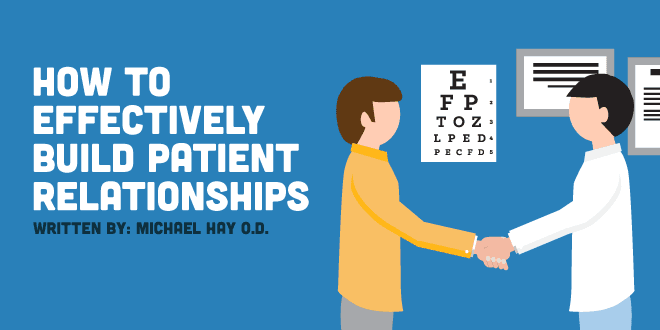Listen to this article instead of reading it:
Optometry has definitely changed over the last twenty years or so.
As Optometrists, we need to adapt as the profession changes. Due to managed care and other obstacles such as the competition that we face, we see more patients but spend less time with them.
Can we still build patient relationships? If we can, how do we do it?
Even with these new challenges, I am a strong believer that you can still build relationships with your patients. This is such an important part of the patient’s experience and it starts from the moment you walk into the exam room until the moment the visit is completed.
I will always remember the dandruff shampoo commercial which stated:
“You never get a second chance to make a first impression.”
And you don’t.
Have you ever taken a step back to see how you may be perceived by the patient? How you talk to a patient, or the body language you use, can either make or break a relationship.
In addition to my day-to-day job at Crystal Clear Eye Associates of Florida affiliated with America’s Best Contacts & Eyeglasses, I also serve as an Area Doctor for National Vision’s Doctor of Optometry Network. In this role I mentor new Optometrists who have joined the company and also conduct peer reviews and auditing to make sure we are always performing to the highest standard.
Here are a few points I usually share with my mentees when it comes to building patient relationships
Introduce yourself and address your patients by name.
When I enter the exam room, I introduce myself to the patient as Dr. Hay. Some doctors use their first names while others use their last names. I tend to be “old school” so I prefer using my last name.
When addressing patients by their name, I use a relatively easy approach: if a patient is younger than me, I call them by their first name. Conversely, if the patient is older than me, I call them by their last name.
I use the patient’s name when addressing them throughout the entire exam. This allows me to remember their name but also makes the exam more personal. In his book “How to Win Friends and Influence People,” Dale Carnegie says, “Remember that a person’s name is to the person the sweetest and most important sound in any language.”
I agree, and believe in saying a name and saying it often.
Get to know your patients.
As I continue with case history, not only do I ask about patients’ needs and what they do for a living, but I also ask them personal questions, like where they are from, what they do for fun or if they have any children.
Patients enjoy talking about what is going on in their lives - this is a great time to build a connection.
A helpful tip for remembering things about a patient is to write special notes in their records that you can bring up in a future visit to make a positive impression. For example, if a patient shares in one visit that she is going on a cruise or a trip to Europe, I will make that notation and ask about how it went during the next visit.
Before I walk in to see any patient, I briefly review the record and any notes I made the previous year.
Take your time during the refraction.
When refracting patients, it is important to allow them enough time to look at the choices and make an informed decision.
All too often, I hear that patients are rushed through this aspect of the exam. This can be one of the most difficult tests for patients, because they fear that they are giving you the “wrong” answers. Taking your time and showing the choices multiple times help to develop a relaxed atmosphere that builds a better relationship.
If the patient does not gain confidence in his physician, he will move on to another for his next exam. I’ve known some doctors who work so fast through refractions, it is as if they were auctioneers.
Try to remember to take a moment and evaluate how well you perform your refractions. You don’t want patients to feel like they just failed a test or question their performance. To minimize that concern, I concisely explain to the patient that I want them to let me know which choice is clearer even though both may be blurry. I give them ample time to make a choice but will repeat it as needed. I also let them know that when the choices are harder to distinguish, then we are closer to the endpoint. I feel this puts their minds at ease a bit.
Be inclusive.
Building the relationship continues even when you are discussing or reviewing treatment options for the patient. I present a few treatment options with the patient and allow them to be part of the decision making.
Patients like to be given options.
For instance, I talk to the patient about lined-bifocals, near vision only and progressive lenses. I discuss the advantages and disadvantages of each and allow them to make the decision. Patients tend to be happier when they are part of the decision-making process.
As you can see, building the patient relationship starts from the moment you walk into the room until you walk the patient to the optical. Even with shorter interaction times, a successful relationship or bond can be made. It is something that you have to work at with each and every patient. Make that connection with the individual and they will certainly return to you for his or her eye care needs.
In addition, patients who have had a great experience in your office are more likely to refer their friends or family to you. Building patient relationships is imperative for building your success.
